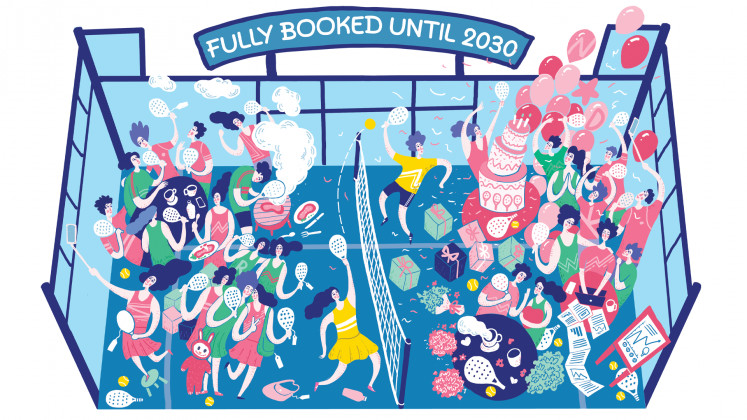(Courtesy of The Jakarta Post)
A time for nastar is a time for indulgence. With its sweet and tangy jam and a slightly crumbly buttery crust, nastar strikes the perfect balance of a light dessert and a lavish snack.
The luxurious taste of nastar, an Indonesian pineapple tart that originates from the Dutch during its occupation across the archipelago centuries ago, does become a goal that local consumers and bakers sought after. For someone who is hosting Ramadhan celebrations, a jar of decadent nastar is a show of generosity and prestige – almost like presenting an exotic tea or a single-origin Ethiopian coffee.
And for these bakers, producing nastar that is rich in texture and taste is an accomplishment all on its own. Finding the recipe that encapsulates the baker’s idealism and the consumers’ preferences can take months; and perfecting it may be a lifelong affair.
Looking at the basics of kue kering, nastar actually shares a similar dough recipe to other cookies in the kue kering family, such as kastengel or putri salju. Though nastar is said to be the substitute for pineapple tarts back in the day, its look and feel don’t actually fit that of the common fruit tart. Some say they are pretty much the Indonesian version of butter cookies, or shortbread.
Yet out of all other kue kering, nastar is possibly the only one that has evolved into a sophisticated variant, demanding bakers to have advanced knowledge and techniques for balance. So much so, nastar’s popularity is equally proportional to the scrutiny it receives by consumers and bakers alike whenever they come across versions whose quality doesn’t measure up to the general expectation.
Read also: How to navigate unwanted questions and survive family gatherings

Thank you!
For signing up to our newsletter.
Please check your email for your newsletter subscription.
A good nastar is an act of balance between a flaky but soft crust, as well as a firm but slightly soft jam filling. If the crust is too flaky, it will leave a lot of messy crumbs and therefore be difficult to enjoy. If the jam filling is too wet, it may end up ruining the entire experience. All of this will be put under scrutiny by nastar lovers long before we get into the issue of flavors.
“In terms of complexity, lapis legit (the ultra-fine layer cake crowned as Indonesia’s top traditional cake by CNN in 2016) comes close. But it doesn’t count as kue kering,” said Tria Nuragustina, food editor at Femina. “There’s no other kue kering, especially those popular during Ramadhan season, that is as meticulously made as nastar.”
The extensive complexities to make nastar is why it continues to be the most premium item in the group.
For nastar bakers, getting the texture right is the first challenge; next comes the flavor profile. At the end of the day, both its texture and flavor will determine the bakers’ level of expertise in crafting the perfect nastar.
A professional baker will always tell any aspiring baker to steer away from using ready-made pineapple jam and opt to create the filling from scratch using real pineapple fruits. “The most important [element] is the filling, the pineapple jam,” said Yvonne Yuen, who specializes in home-style Shanghai cooking and owner of YY Private Dining.
A pro-tip in crafting pineapple jam filling from scratch is to first identify the most appropriate batch of pineapples – firm to the touch, slightly dry and crunchy when sliced, and not too ripe. In Indonesia, these recommended batches are primarily grown in East and West Java (Blitar and Bogor), as well as South Sumatra (Palembang). Honey pineapples are also recommended, but be sure to pay attention to its texture, because plenty of this particular batch tend to contain too much juice that may ruin the jam’s consistency.
Choosing the right pineapple variety is also important because it will determine the signature flavor profile of your nastar. “I don’t like my pineapple jam to be too sweet,” said Luvita Ho, food content creator whose tutorial on making nastar has been viewed two million times. Luvita tends to avoid honey pineapples due to its high sugar content and water retention, “so it takes a longer time to boil.”
Read also: Five questions for modest fashion influencer Mega Iskanti
According to Heidy Prasetya, owner of Bon Ami Bakery in Surabaya that has been selling nastar since the 1970s, the process of making a fresh batch of pineapple jam filling “can take three to four hours” of constant mixing. Once the water has receded, you will have a sticky, golden jam ready to cool down. At this stage, it would be advisable for any baker to check on the jam’s consistency before rolling the jam into the crust. Once all the elements have come together, perhaps the one of the crucial final touches is the shape of the nastar itself.
“Nastar should be nicely rounded, truly glazed all over the surface, and not [have the crust] crack,” said Tria. A jar of visually satisfying, uniformly golden nastar might look industrially made, but there's nothing much industrial about them.
Venyany Listya spent one year mastering her craft to create a nastar that glows without any cracks. “You can only tell if a nastar is going to crack after the first bake in the oven,” said the cake connoisseur and owner of the Bali-based VLO.VEN Patisserie and Cita Cita Baking Studio. The first bake allows the nastar to be cooked until it is mostly done, which means that major cracks at this stage can be unsalvageable.
“This happens for many reasons,” said Venyany. “The pineapple filling might be too wet, or there’s too much filling, or the dough is overmixed, or the oven is too hot, or the egg wash layer [on the surface] is too thin.”
Due to its meticulous process, a great nastar is a showcase of the baker’s dedication, craftsmanship, and hyper-efficiency in making traditional snacks. And, you can taste it when it’s perfectly executed: buttery biscuit with a nice sweetness and a gentle pang of tanginess that melts in your mouth. One is never enough to satisfy the taste buds.
Surely then, a tastefully done nastar has the ability to elevate a baker’s profile, as well as the brand of his or her other products. Tria agreed, further saying that a well-made nastar is also a way to “show off your brand.”
Nowadays, a more modern take of nastar comes in different shapes and forms, including the practice of infusing the crust with matcha flavors, or changing the jam filling from pineapple to chocolate or date fruits. In fact, birthday cakes and ice cream that replicate nastar’s flavor profiles have been quite popular in recent years, turning the snack into full-blown dessert menu items. NANACA Shop, for instance, an experimental food and beverage shop based in Jakarta, concocted a nastar-based gelato using ingredients made from scratch.
With such a vast variety of nastar in its presentation, texture and flavor profiles, it’s little wonder that nastar has sparked tasty debates at social and family gatherings.
Still, a traditional nastar transcends time. The recipe that Bon Ami uses today continues to woo its customers as much as it did back in the 1970s. Using a generous amount of high-quality butter and a hefty filling, its nastar remains one of the most popular items among customers. In fact, "it has gained even more popular in the last few years," said Heidy.
Afterall, a piece of a really good nastar is enough to be oh-so-deliciously addicting.
Read also: Sprucing up your home for a Lebaran open house
This article is part of The Weekender, which comes out on the Saturday edition of The Jakarta Post. It offers a variety of lifestyle and culture articles aimed at enriching your reading experience. Subscribe
here to get access to the Saturday edition and all other premium content from the Post.























